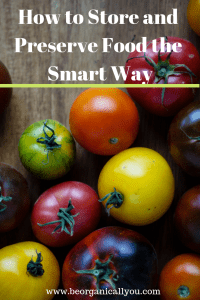The 7 Smartest Ways to Store and Preserve Food

Store and Preserve Food
The Smartest Ways to Store and Preserve Food
Storing and preserving has become a bit of a lost art and it’s a shame. What do you do when you come across a great deal at the grocery store or the farmers market? What do you do when you’re offered a deal on a bushel of produce that you can’t pass up? What do you do when you have a bumper crop of green beans, squash, or tomatoes? There’s only so much of anyone food you can eat before you get sick and tired of it.
If you know how to preserve food, you can store and use it throughout the year. Keep reading to find out how.
Freeze It
A great way to preserve food is to start is by freezing it. You can cook up your harvest in some of your favorite freezer-friendly foods, or clean and precook them and toss them in the freezer. This is also a great way to store fruits like berries and peaches that don’t last long once they are ripe. The only disadvantage of freezing food is that you’re limited by the amount of room you have in your freezer. Be sure to get in the habit of labeling frozen food well so you know what it is before you pull it out to thaw and how long it’s been sitting in the freezer.
Freezer Meal Containers
Freezing is another great way to preserve food from the garden, or when you were able to get a deal at the local farmers market, or the grocery store that was just too good to pass up. Often I end up freezing the raw produce or meat, but my favorite way to preserve things when it comes to the freezer is to cook and freeze entire meals. It makes dinner time go much easier and even makes for quick and easy take and heat lunches.
The key to successful freezer cooking is having containers that will preserve your meals and make it easy to reheat them. That’s where these freezer meal containers come in handy. They are safe to use in the freezer, microwave, dishwasher, and even the oven. They are inexpensive and can be used a few times before disposing of them in the recycle bin. According to the manufacturer, you’re supposed to dispose of them after one use in the oven. Personally, I find I can safely use them a couple of times, but use your own judgment.
The containers are large enough to hold a freezer meal for one person. That means I can make my favorite freezer meals, portion them out, and stack them up in the freezer. When I need a healthy, homemade lunch to take to work, I grab one container. If it’s time for dinner, I pick as many containers as I’m feeding people. This is perfect when your kids are getting older and aren’t always home for dinner.
As an added bonus, the single-size containers makes it easy when family members have different dietary needs or are simply in the mood for different food. You can grab one container of chicken, green beans and rice, and another one with chili. Defrost and heat them both at the same time and custom made dinner is done.
Since these containers are microwave safe, they are perfect for taking lunch with you to the office. Rinse them and when you get home, toss them in the dishwasher. The clear lid allows you to see what’s in it. That being said, I still recommend that you label your containers. I find masking tape across the lid or even a piece of paper taped down works well. You can even include reheating instructions if you know you won’t be there to reheat the food.
Also, because these portable freezer containers are so inexpensive, they are perfect for taking food to someone recovering from an illness or loss in the family. Instead of sharing your best Pyrex dishes or making a big batch of a freezer casserole, you can take a few homemade, proportioned meals to them that are sure to be appreciated. Perfect for new moms too while they recover from giving birth and caring for a newborn.
Dehydrate to Preserve
If you don’t have a lot of space, consider dehydrating food. You can start by using your oven on the lowest setting. Try dehydrating some apple slices, or any type of food to use in baking and cereal throughout the year. Then explore further and come up with fun snacks like kale chips, banana chips, and even dried veggies that you can use in soup.
Electric Food Dehydrator
If you’re short on space, dehydrating is a great way to preserve some of your favorite fruits, vegetables, and even meat. If you’re a big fan of dried fruit, veggie chips, or jerky, getting an electric dehydrator to make your own can be a very smart move. Dried food is expensive and you never quite know what’s in it and it has been treated with unless you make your own. It won’t take you long to recoup your investment in a dehydrator.
Dried fruit is a great addition to your favorite cereal, oatmeal, or granola. It also makes for a yummy snack on its own or mixed into your own homemade trail mix. My biggest problem with store-bought dried fruit aside from the high cost is that you never know what the fruit has been treated with to make sure it lasts and looks pretty in its dried form. Aside from that, you don’t know how high quality the fruit was, to begin with, and what pesticides and the likes it was treated with before being dried. Making your own dried fruit to top your cereal gives you full control over the entire process.
The same goes for veggies. You can dehydrate just about any type of vegetable to make your own dried soup mixes. They are a great way to save space and make fixing dinner during the winter months easy peasy. If you’re more in the mood for healthy snacks, make your own veggie chips. Kale chips are always a favorite around here. They are much easier to make in an electric dehydrator than in an oven, where I’ve been known to burn a few batches. (Which is sad and stinks up the house).
And then there’s meat. Yes, you can dry meat and make your very own jerky. If you’ve bought a bag of beef jerky at the store, you know how pricey it has become. Why not make your own. Again, you control all the ingredients, and you can play with different flavors to come up with your very own jerky.
What I love about the dehydrator is that it’s a great intro-level dehydrator. It’s very affordable and because the dehydrating trays nestle into the machine, it doesn’t take up a lot of space. It’s the perfect model to start dehydrating. If you find you enjoy the process, you can upgrade to larger, and more expensive models down the road, while still taking advantage of this model to do some of the dehydrating for you. Give it a try… you won’t regret it.
Food Tray Dehydrator
Most of us start with a fairly small, usually round dehydrator that holds just a couple of trays. It’s a great start and the perfect way to try things out and see if dehydrating makes sense for you and your family. After a while though, you may be ready to expand and dehydrate more food at once.
If you’re feeding a large family, have lots of produce to dehydrate from the garden each summer and fall, or just want to be able to make larger batches of dried fruits, veggies, or homemade jerky, you’ll be ready to upgrade to a larger model. If that’s the case for you, I recommend a tray dehydrator. It’s a very affordable electric dehydrator that gives you 15 square feet of drying space. If that sounds like a lot of space, it’s because it is. The good news is that the dehydrator doesn’t take up all that much space because of the tightly spaced, vertical 9-tray system.
Dehydrating large amounts of food all at once has never been easier. Just load up the trays, set the temperature and you’re good to go. The 7-inch fan and the design of this dehydrator work together to ensure even dehydrating. There’s no need to rotate trays or move the food around. Just set it and walk away. It doesn’t get any simpler than that.
Each tray has easy to clean poly screen inserts that will also keep your food from sticking as it dehydrates. That makes for easier food removal and clean up when you’re done. There’s nothing worse than having a big mess to clean up, or losing a large portion of your product to being stuck to the equipment. That’s not going to happen here.
One thing you should be aware of before you buy is that this dehydrator makes a bit of noise. It’s a good bit quieter than my dishwasher, but you can hear it when it’s running. If that’s going to bother you, sit it in the garage or basement, or even a spare room to dehydrate. It doesn’t bother me enough to move it out of the kitchen and usually, we run it overnight in the first place.
This is a great dehydrator that allows you to dry a lot of food at once. Perfect for large batch processing of all your favorite fruits, vegetables, and meats for making jerky.
Non-Stick Dehydrator Sheets
Dehydrating is a great way to preserve fruits, vegetables, and even meats. It’s also a wonderful way to make healthy snacks like veggie chips, living bread, raw food treats, and the likes. For most dehydrating, the included mesh trays for your dehydrator work just fine.
If you’re processing sugary fruits like peaches, or bananas to make banana chips, for example, things can get a little sticky. I mean that in a literal sense. These fruits can get stuck in the drying trays, making it hard to remove them when they are done.
The solution is non-stick dehydrator sheets that lay right on top of the mesh screen. These sheets are great because the stickiest fruit peels right off of them. When you’re done, just wash the sheets with a little hot water and soap, allow them to dry completely (this is important), and store them until you’re ready to use them again.
To store the sheets, you can either stack them up and store them on one of the trays when not in use, or roll them up and stick them inside an empty paper towel roll. Either way, they are out of the way and safely stored until you’re ready to use them again.
Having these sheets is by no means essential for using your dehydrator, but it’s a nice addition to have. It gives you more options and makes your dehydrator an even more versatile small kitchen appliance. While they won’t wear out anytime soon, it’s nice to know that you can order more as needed without spending a fortune.
Pickle It
Another favorite old-fashioned way to preserve food is to pickle it. Pickling involves submerging the produce in a brine made of salt, sugar, water, and various pickling spices. The most common pickled item is, of course, pickles and it’s a great place to start. But don’t stop there. You can pickle peppers, okra, cauliflower, and a wide variety of other veggies and even fruits. Play with it and see what you like. Pickled veggies make a great addition to sandwiches and salads throughout the year.
Cold Store It
Last but not least let’s talk about the simplest way to store food. Things like root vegetables, apples, and cabbages store well in a dry, cool, and dark place. This used to the reason any house had a root cellar. Today your pantry might be a good place to store this type of food. If you’re lucky enough to have a basement, you can set up some shelves to keep a lot of produce for months to come.
Here are some great products to help you with your canning and preserving.
Can It
Canning is one of the most versatile ways to preserve food. You can make and can anything from jelly and pie filling to chili and green beans. Canning has the added advantage of not taking up any space in your fridge and freezer. You can store your canned goods in the pantry, on a shelf in the kitchen, or anywhere in the basement. Heck, I’ve been known to keep canned goods stuck under the spare bed if I’m running out of the room. Properly canned food also stores a lot longer than any other method.
Bath Canner
Canning is a very cost-effective way to preserve and store all kinds of fresh produce. It’s also fairly easy and an inexpensive preservation technique to get into. Aside from canning jars the main piece of equipment, you’ll need is a water bath canner. This is nothing more than a large pot with a jar rack that your canning jars will sit on.
That’s exactly what you’ll get with this graniteware water bath canner. The pot is a great size for canning, but I’m sure it will also come in handy when you’re making a bit pot of soup or chili. I’ve also been known to use mine to boil pasta in a pinch.
Let’s get back to the main reason for getting this inexpensive pot through – canning. It’s lightweight and easy to use. It works well on both gas and electric burners. Be aware that this pot is not recommended for glass top stoves. As I already mentioned it comes with the metal canning jar rack. This will sit in the pot and keep the glass jars from touching the bottom of the pot. Why is this important? Because having the glass in direct contact with the bottom of the pot can cause your jars to bust open.
If you find yourself cooking throughout the year in this pot, you’ll appreciate the fact that it is dishwasher safe. My favorite feature is the porcelain surface with a steel core for even and fast heat distribution. This means I can get my water bath up to temperature quicker and it’s easier to keep it in the optimal temperature range. That just makes canning a lot easier and it goes faster. If you find yourself processing batch after batch of canned goods throughout the summer and fall, that makes a big difference.
The 21.5-quart water bath canner holds 7 one-quart jars, 9 one-pint jars, or 12 half-pint jars. That’s plenty big for the average family. If you find yourself doing larger batches of canning, consider picking up two of these to use in tandem. At the price, this is something you can easily do, even on a tight budget.
Home Canning Book
If you’ve even just considered giving canning a try or bought a set of canning jars to use for storage or even drinking glasses, you know that Ball is one of the biggest names in the canning world. If they publish a book on canning, it’s something worth paying attention to and this complete book about home canning does not disappoint.
Yes, there are a lot of free resources about canning available online, but there’s just something about having a big book sitting on your kitchen counter that you can reference throughout the canning process. It’s also nice to have and leaf through for inspiration when you’re facing a big batch of products that needs to be “put up”.
Canning is a great way to enjoy healthy, nutritious foods throughout the year. It allows you to preserve everything your garden has to offer throughout the year and it allows you to take advantage of great offers from the farmers market.
As expected from a book like this it has a lot of recipes for a large variety of canned products you can make right at home in your kitchen. What makes this book such an invaluable resource though is all the extra information packed into these pages. You’ll find detailed information on the basics of canning and each step of the food preservation process.
Safety is crucial when you’re preserving food that you and your family will eat months from now. This book has a lot of information about foodborne illnesses and how to prevent them. You have to make sure you kill bad bacteria through preservation and to make that happen, you have to follow a time tested process that this book will teach you.
This is a book on canning that you will come back to again and again, to review processes, take advantage of the handy guide on produce weight vs. volume, and of course to try some of the amazing recipes included. I highly recommend you add this to your library of cooking and homemaking books.
Canning Kit
When I first started thinking about canning, what scared me most was handling the hot jars submerged in boiling water. The idea of grabbing hot, wet, slippery canning jars with my kitchen tongs and wrestling them out of the pot and onto a folded towel on the counter sounded a bit terrifying. To be honest, it’s what kept me from postponing canning for a year or two.
I finally broke down and ordered a canning kit that included jar tongs. These special little tongs wrap around the jar, making it easy and safe to handle even the hottest canning jars. While the tongs didn’t disappoint, I was pleasantly surprised by how helpful the other canning accessories in this kit have been.
Here’s what’s included in this canning kit. There are the jar lifter tongs that I already talked about. Also included is a set of kitchen tongs. These have been coming in handy to left canning lids out of the pot when boiling them to sterilize, but also to handle hot food that needs to get into the jars.
The kit also includes a funnel, which makes it easy to pour liquids into jars without the risk of spilling it all over the jar and the counter. The funnel is fairly wide, making it easy to pour chunky things like apple pie filling for example into canning jars.
When you’re canning, you need to tighten lids after you get the hot jars from the water bath. The included jar wrench is surprisingly helpful with this. Much safer and easier to do than my old method of grabbing some kitchen towels to tighten the lids. The kit also includes a bubble remover, a lid-lifter, and a digital kitchen timer. It’s nice having everything you need to can in one spot. I keep it all in the box to make sure it stays together.
This kit is a great addition to your kitchen. It’s very affordable and worth every penny. I think you’ll find it just as helpful as I have. As a bonus, everything is very pretty spring green.
Mason Jars
I love mason jars. They are of course great for their intended usage – canning, but I find myself grabbing them throughout the year for all sorts of different things. We use ball mason jars as drinking glasses, flower vases, storage for leftovers, to bring lunches to work and more. Older jars that are past their canning prime can be turned into all sorts of arts and crafts around the house. Take a quick look at Mason jar crafts on Pinterest and you’ll find a lifetime’s worth of ideas.
In addition to canning, they are a great storage solution for the freezer as well. With more and more health concerns popping up about plastic storage containers and the risk of contamination into the foods we eat, I feel much safer using glass instead. Ball jars have yet to break on me in the freezer or in the canner, which is important in my book.
It’s important to note that once you freeze a jar – any canning jar, you should no longer use it for canning. Keep that mind when you start to make things like freezer jam or use jars as freezer containers. Keeping good track of what can go in the freezer and what’s used only for canning is important.
Before you start to can anything, think about what serving sizes you end up using any particular food in. For example, if you use only half a jar of spaghetti sauce at a time, and then struggle to use it all up before it goes bad, pick a smaller jar when you make and can your own. The same goes for jelly. If you’re not a big jelly or jam eater, make small batches and can them in small little half-pint jars.
What I love about these mason jars is that they come in a huge variety of sizes. On top of that, you can pick regular or wide mouth jars. Start your collection and I’m sure you’ll use these jars on a daily basis for years to come.
Automatic Jam and Jelly Maker
If you love your bread maker and rice cooker, you’re going to love having an automatic jam and jelly maker. It’s one of those nifty little appliances that can save you a lot of time and effort. If on the other hand, you’re the kind of person that would rather knead bread by hand and uses the stovetop instead of a slow cooker to make soups and stews, this may not be the best choice for you.
What this handy little electric appliance does for you is heat, stir, and cook a batch of homemade jelly or jam on autopilot. You add the ingredients, turn it on and come back to yummy jam ready to pour into canning jars. From there, you can process the jars in a hot water canner, freeze the finished fruit preserves, or of course start eating it.
If you find yourself making a good bit of homemade jelly and jam throughout the year, this would make a great addition to your kitchen. If you end up making one or two small batches per year, it is probably overkilled. Where this will come in very handy is for anyone that loves making homemade jelly, but has a hard time standing at the stove stirring pots for long periods of time. It would make a great gift for an elder family member or someone suffering from tendonitis, or arthritis for example.
While this is marketed as a jam and jelly maker, it is actually a lot more versatile than that. When you break it down, it’s an electric cooker with built-in stirring paddles. When you look at it that way, it opens up all sorts of cooking possibilities. Use it to make spaghetti sauce, small batches of soup, or any type of sauce that involves a lot of cooking and stirring. It’s great for tomato sauce, barbecue sauce, and the likes. That opens up all sorts of cooking possibilities and makes it a much more versatile and usable small kitchen appliance.
The automatic jam and jelly maker is a small appliance that won’t take up any more room than your slow cooker on the kitchen counter. It’s also pretty light-weight, making it easy to move it from the cabinet to the counter and back.
What I love best about it, is that it allows me to make small batches of jam and jelly throughout the year whenever there’s extra fruit sitting on the counter. No matter how busy you are, you can turn on this jelly maker and have it take care of the cooking and stirring for you. No excuse to not have fresh homemade jam on the breakfast table.
Glass Food Storage Containers
Freezer bags are fine for storing food in your freezer, but with plastic getting more and more controversial, I’m always looking for options that involve as little plastic as possible. While I’ve used canning jars in the freezer in the past, they aren’t always the best use of space. I came across these glass food storage containers and have been using several sets of them ever since. They are perfect for freezing and storing smaller amounts of fruits and veggies from the garden.
The glass is sturdy, high-quality glass that will keep your food safe. You can also take it from the freezer to the oven or the microwave. They are even dishwasher safe, making for easy clean up as well. If you do a lot of meal planning and find it helpful to make individual meals ahead of time, these containers will fit the bill perfectly.
I also find them invaluable for taking lunches to work. I can pre-make my meals for the week, or throw leftovers from dinner in the container, store them in the fridge or freezer, and then take them to work with me. The lids snap on securely, so there’s no need to worry about spills and leaks. At work, the food can quickly be heated in the microwave. As I mentioned, the containers go straight to the dishwasher when I get home.
If you’ve been looking for a workable alternative to plastic containers, this is a great option. The lids are made from plastic, but it is BPA save and not much of it will come in contact with your food. The seal around the lid and the four snaps keep your food inside the container, even if you pack everything in a bag.
If you’re eating and storing a lot of tomato products (leftover spaghetti or soup for example), you know that tomato will stain plastic-like crazy and there’s no way to get it all out. With these glass containers that are not an issue.
Ready to get started but need some recipes for your canning projects? Sign up below for some food preservation recipes.
Be happy. Be healthy. BeOrganicallYou!



